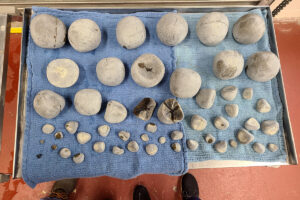Dysphagia in Newborn Foals

Dysphagia, or difficulty swallowing, can have serious consequences for foals. At the 2025 Cavalcade Education Equine Reproduction Seminar, held on Jan. 8, in Red Hook, New York, Lauren Holley, BVSc (Hons), Dipl. ACVIM, of Rhinebeck Equine, also in New York, explained the importance of diagnosing dysphagia in foals early and properly managing them to prevent respiratory dysfunction and aspiration pneumonia.
Critical First Steps: Assessing the Newborn Foal
Holley highlighted the importance of a neonatal physical exam at birth to catch dysphagia and other potential abnormalities early. With this hands-on physical exam, the veterinarian should evaluate:
- Vital signs;
- Heart sounds;
- Limb deformities;
- The umbilicus; and
- The respiratory system.
Signs of Respiratory Dysfunction in Foals
Aside from milk coming out of the nostrils—considered a definite sign of disease—other clinical signs of dysphagia in the foal include:
- Nasal discharge;
- Abnormal respiratory rate and effort; and
- Respiratory noises, such as stridor (abnormal sounds heard when inhaling).
“The most concerning clinical sign remains milk coming out of the nostrils, which requires immediate veterinary attention,” Holley said. “If this is observed, the foal should be muzzled and separated from the mare while waiting for the vet, as continued nursing increases the risk of aspiration pneumonia from milk pooling in the lungs.”
Causes of Dysphagia in Foals
Dysphagia usually stems from two primary issues: one functional, the other structural.Functional dysphagia occurs relatively frequently and often appears in cases involving prematurity, neonatal encephalopathy (also called “dummy foal” syndrome), or systemic illness. Structural issues, though less frequent, include cleft palates, cysts, and esophageal dysfunction.
Diagnosing Dysphagia in Foals
If practitioners suspect dysphagia in foals, they might perform blood tests to assess systemic inflammation and organ function and pursue diagnostic imaging in the form of ultrasonography, radiography, or endoscopy. “Endoscopy is considered the most important diagnostic tool as it allows us to directly visualize the upper airway and trachea for evidence of aspiration or structural abnormalities,” said Holley. Endoscopic videos can reveal weak or collapsed pharyngeal muscles, inflammation, and the presence of milk in the trachea.
Treating Dysphagia
Holley said the goals when treating dysphagia in newborn foals include three main objectives: Stop aspiration, reduce inflammation, and address secondary bacterial pneumonia. Veterinarians might treat foals that have dysphagia by placing a nasogastric feeding tube and administering anti-inflammatory medications and broad-spectrum antibiotics. In select cases veterinarians recommend antioxidants—notably vitamin E and selenium—to address nutritional deficiencies that negatively affect foals’ neuromuscular function.
Foals with severe structural abnormalities or neurologic issues might need longer-term management, such as bucket feeding rather than nursing until weaning. Veterinarians often perform repeat endoscopic evaluations on these foals to monitor their progress and guide treatment.
Take-Home Message
Dysphagia in newborn foals can be serious, but it often improves with early diagnosis and treatment. Most foals recover well, especially when the cause is functional—those cases usually resolve within five days. Because complications such as aspiration pneumonia can develop quickly, horse owners and veterinarians must act promptly, identifying the cause of dysphagia and implementing appropriate supportive care to give these foals the best chance at a full recovery.

Related Articles
Stay on top of the most recent Horse Health news with

















